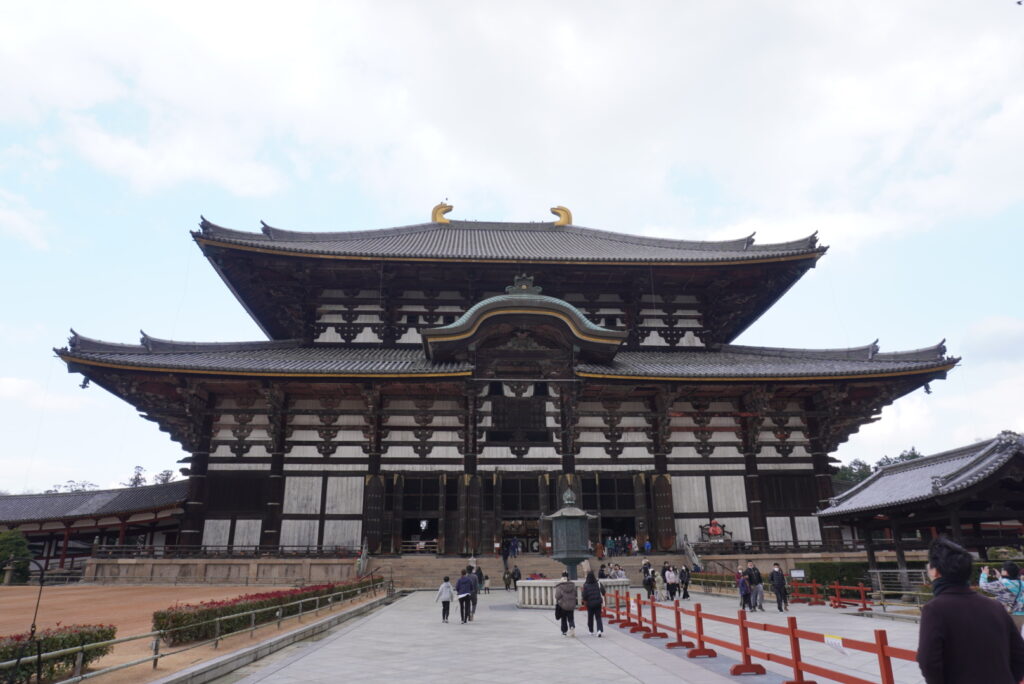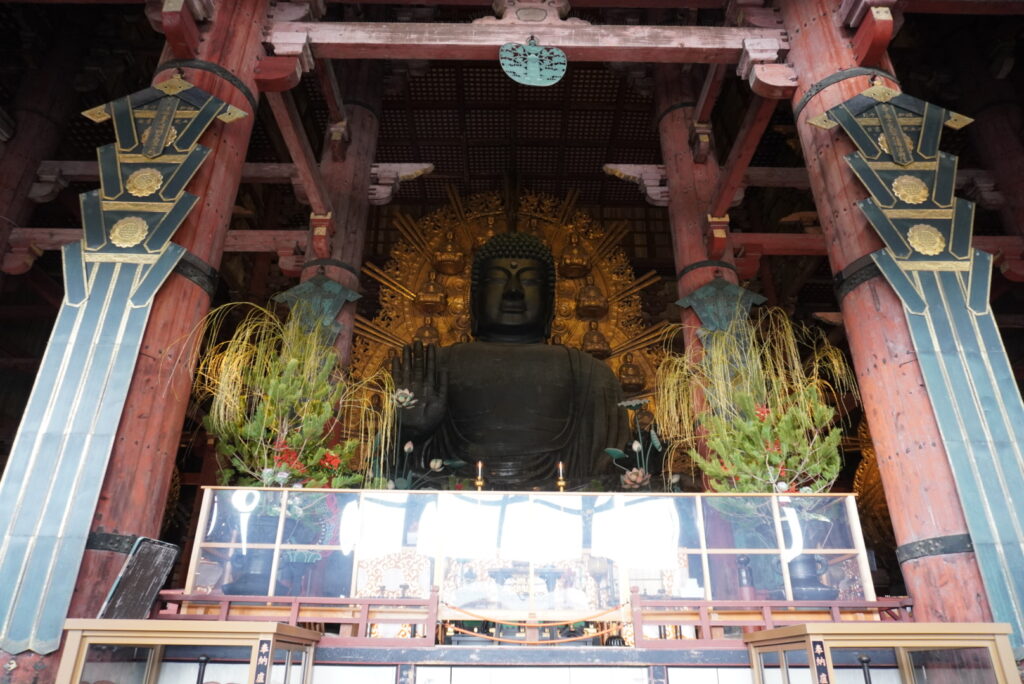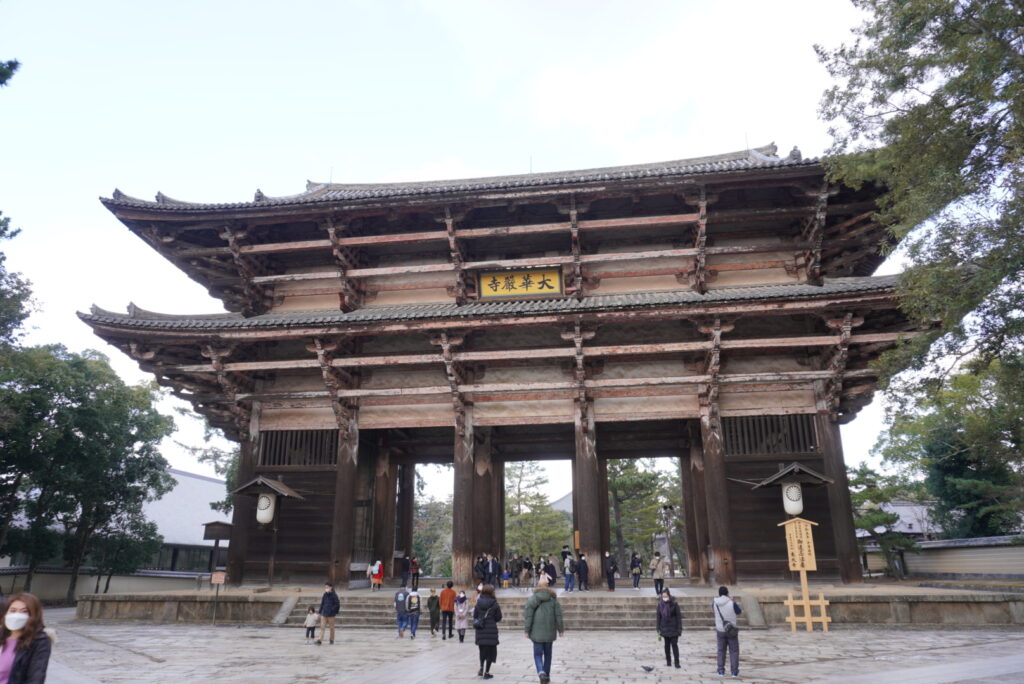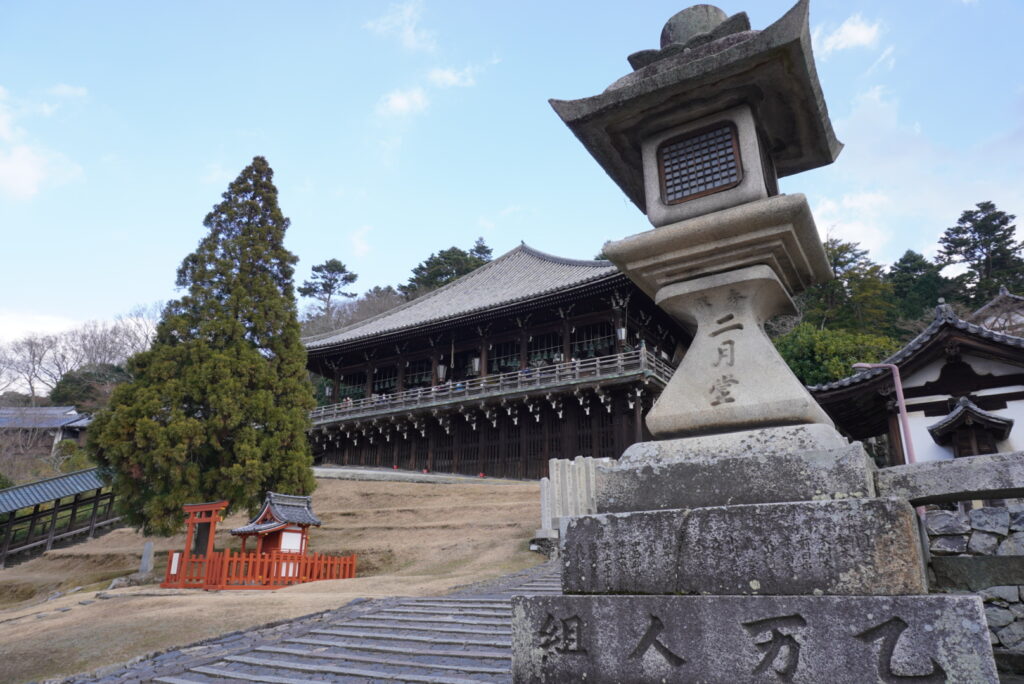Introduction

Todaiji Temple, located in Nara City, is a symbol of Japanese Buddhist architecture and a historic UNESCO World Heritage Site. founded in the 8th century, Todaiji Temple is famous for its Daibutsuden (Great Buddha Hall), the largest wooden structure in Japan, which attracts visitors with its grand scale and beautiful architectural style. Inside the Daibutsuden stands the gigantic Rushanabutsu (Great Buddha), which stands approximately 15 meters high, and its overwhelming presence is worth seeing.
The historical value and cultural beauty of Todaiji are not its only attractions. The temple’s natural scenery can be enjoyed from season to season, with the cherry blossoms in spring and the autumn leaves in fall beautifully decorating the temple grounds. Todaiji Temple is also located in Nara Park, where many deer roam freely. The deer are one of the symbols of Todaiji and a major attraction for visitors.
Todaiji Temple provides an excellent opportunity to experience the history of Buddhism and traditional Japanese culture. Visitors can experience the depth of Japanese religion and culture by seeing the historical architecture and Buddhist statues up close. There are also many other places of interest in the area around Todaiji Temple, and a walk around the temple will allow you to fully enjoy Nara’s rich history and nature.
When you visit Nara, be sure to visit Todaiji Temple and experience its magnificent history and beauty.
History and Culture of Sightseeing Spots
Historical Background
Todaiji Temple was founded in the 8th century during the Nara Period. Emperor Shomu, the founder of the temple, built the Great Buddha (Rushanabutsu) with the aim of making Buddhism the guardian of the nation. The casting of the Great Buddha began in 743, and its completion was celebrated with an “opening of the eyes” ceremony in 752. Many people gathered from all over Japan for this grand ceremony.
Todaiji Temple has played an important role in the history of Buddhism in Japan. In particular, from the Nara to Heian periods, Todaiji served as the nation’s central Buddhist temple. Although Todaiji has been rebuilt many times due to frequent disasters and fires, it has been restored each time and continues to retain its grandeur to this day.
Cultural Features
One of the cultural features of Todaiji Temple is its magnificent architecture. The Daibutsuden is known as the largest wooden structure in Japan, and its size and beauty overwhelm visitors. The Daibutsuden Hall houses the 15-meter-high Great Buddha (Rushanabutsu), whose majestic appearance is well worth a visit.
Todaiji Temple also houses a number of important cultural properties. For example, the Kongorikishi statue in Nandaimon is considered one of the greatest masterpieces in the history of Japanese sculpture. These cultural assets add to the historical and artistic value of Todaiji Temple.
In addition, Todaiji Temple offers natural beauty in each of the four seasons. In spring, the cherry blossoms are in full bloom, and in fall, the autumn leaves beautifully decorate the temple grounds. The combination of natural beauty and historical buildings is a deeply moving experience for visitors.
Places to visit
Suggested times to visit
The best times to visit Todaiji are spring and fall. In spring, the cherry blossoms are in full bloom and the temple grounds are tinged with pink. Especially in early April, the cherry blossoms are at their best and the scenery is beautiful. In autumn, the leaves turn beautiful colors, and the best time to see them is from mid-November to early December. At this time of year, the red and yellow colored trees combined with the historical buildings of Todaiji Temple make for a wonderful sight.
Major sights and popular tourist attractions
Daibutsuden (Great Buddha Hall)
The symbol of Todaiji Temple, the Great Buddha Hall is known as the largest wooden structure in the world. Inside the hall sits the 15-meter-high Daibutsuden (Rushanabutsu), whose grandeur overwhelms visitors. In addition, there is a pillar called “Hashira no Ana” (hole in the pillar) in the Great Buddha Hall. It is said that if you pass through this hole, your wish will come true, and many tourists try to do so.

Nandaimon (Nandaimon Gate)
Nandaimon is the main gate of Todaiji Temple and is designated as a national treasure. Guarding this gate are the Kongorikishi statues carved by Unkei and Kaikei. These statues are considered to be among the greatest masterpieces in the history of Japanese sculpture, and their powerful appearance is well worth seeing.

Ruins of the East Pagoda (Toto-seki)
Todaiji once had two gigantic pagodas, but today only the ruins of the pagodas remain. The East Pagoda Ruins is a place where visitors can feel the magnificent history of the pagodas. The base and foundation stones of the pagodas still remain, and one can recall the scale and majesty of the pagodas of that time.
Nigatsudo
Nigatsudo is one of the most important buildings on the Todaiji Temple grounds and is famous for the Shunie event held every year in March. This event has a history of about 1,200 years, and the fire ritual “Omizutori” is especially worth seeing. The Nigatsudo Hall also offers a beautiful view of Nara City.

Points to note at sightseeing spots
When visiting Todai-ji Temple, please note the following points:
- Crowded: The temple is extremely crowded on weekends and holidays, especially during the spring and fall tourist seasons. Visit early in the morning or evening on weekdays for a more relaxed sightseeing experience.
- Dress: The Todai-ji Temple site is vast and there are long distances to walk. Wear comfortable shoes and dress appropriately for the season. Bring a hat and sunscreen in summer and warm clothing in winter.
- Manners: Todaiji Temple is also a religious site, so please visit with courtesy. Photography is prohibited in some areas, so please visit with caution.
Access
Access from Nara Station
Access to Todaiji Temple from Nara Station is very convenient. The first option is to take a bus from Nara Station: take the city circular bus from JR Nara Station or Kintetsu Nara Station and get off at the “Daibutsuden/Kasuga Taisha-mae” bus stop. The bus ride takes about 10 minutes, and the Todaiji Temple is about a 5-minute walk from the bus stop. It is also accessible on foot, and takes about 20 minutes from Nara Station to reach Todaiji Temple. It is recommended that you take a walk through Nara Park on the way to the temple.
Access from Shin-Osaka Station
The most convenient way to get to Todaiji Temple from Shin-Osaka Station is by train. First, take the JR Tokaido Line from Shin-Osaka Station and transfer to the JR Yamatoji Rapid at Osaka Station. Get off at Nara Station, which takes about one hour. From Nara Station, as mentioned above, you can access Todaiji Temple by bus or on foot. Another route is to take the Midosuji Subway Line from Shin-Osaka Station and transfer to the JR Yamatoji Rapid at Tennoji Station, which also takes about one hour to Nara Station.
Access from Kansai International Airport
There are two ways to get to Todaiji Temple from Kansai International Airport: by train or by bus. If using a train, take the Nankai Railway to “Namba Station”, then transfer to the Kintetsu Nara Line and get off at “Kintetsu Nara Station”. The trip takes about one and a half hours. From Kintetsu Nara Station, you can access Todaiji Temple on foot or by bus. By bus, there is a direct limousine bus service from Kansai Airport to Nara, which takes about 1.5 hours to Nara Station. From Nara Station, you can access Todaiji Temple by bus or on foot.
Access to Todaiji Temple is very convenient and can be easily reached using Nara’s major transportation systems. Please check the route in advance and enjoy a pleasant trip.
Hours of Operation, Admission Fees
Business Hours
Opening hours of the Daibutsuden, the main area of Todaiji Temple, vary depending on the season. Generally, it is open from 7:30 a.m. to 5:30 p.m. from April to October and from 8:00 a.m. to 5:00 p.m. from November to March. Hours are subject to change during special events and functions, so visitors are advised to check the official website for updates before visiting. Other areas such as Nigatsudo and Sangatsudo also have similar hours of operation.
Admission Fees
Admission fees for the Great Buddha Hall of Todaiji Temple are as follows
- Adults (junior high school students and older): 800 yen
- Elementary school students: 400 yen
This allows visitors to see the magnificent Great Buddha up close in the world’s largest wooden structure. Admission to the Daibutsuden does not include admission to the Daibutsuden and Todaiji Museum. Set tickets are also available. The Todaiji Museum features exhibits on the history and culture of Todaiji for a deeper understanding of the temple.
Discounts and Privileges
Todaiji Temple also offers group discounts for groups of 30 or more people. In addition, admission is free for disabled persons with a disability certificate and one caregiver. Special exhibitions and seasonal events are sometimes held, and participation in these events is a great way to enjoy a richer sightseeing experience.
Cautions
When visiting Todaiji Temple, it is important to plan according to the crowds. Especially during the spring and fall tourist seasons and on weekends, the temple is often extremely crowded, so visiting early in the morning or late in the evening on a weekday will allow for a relatively relaxed visit. Also, be sure to observe the temple in a quiet and respectful manner, as it is a religious site.
Summary
Todaiji Temple, a symbol of Japanese Buddhist architecture in Nara City and a UNESCO World Heritage Site, was founded in the 8th century and is famous for the Daibutsuden, the largest wooden structure in Japan, which houses the gigantic 15-meter-high Rushanabutsu, or Buddha. Todaiji Temple provides an excellent opportunity to experience Buddhist history and traditional Japanese culture, and to enjoy the natural scenery of the four seasons. The cherry blossoms in spring and the autumn leaves in fall are especially beautiful and well worth a visit.
Highlights include the Great Buddha Hall, Nandaimon (South Gate), the ruins of the East Pagoda, and Nigatsudo (Nigatsudo Hall), each of which evokes a deep sense of history and culture.
Visit Todaiji Temple and experience its magnificent history and beauty, as well as Nara’s culinary culture to the fullest.



